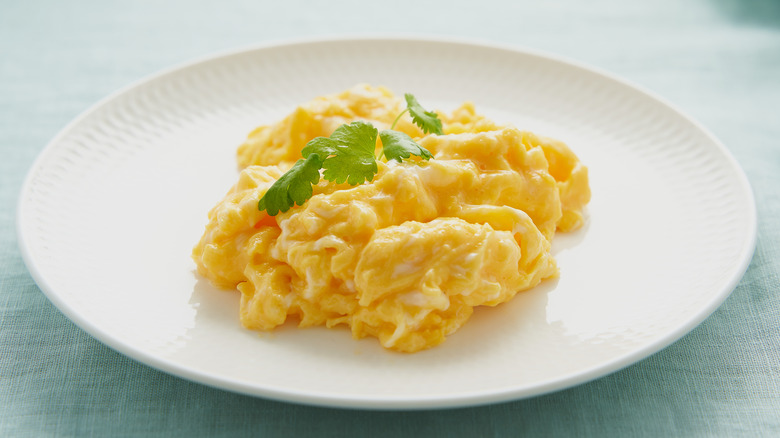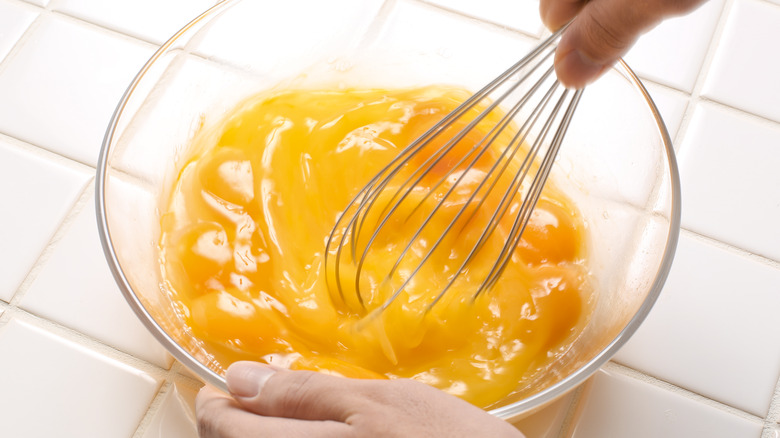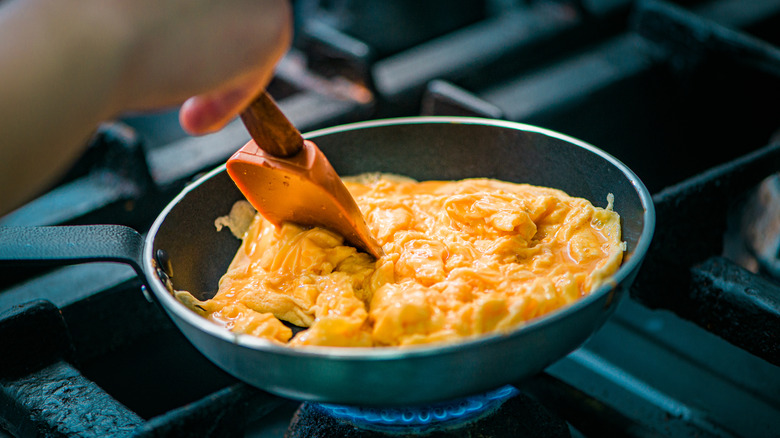The Mason Jar Hack To Make Scrambled Eggs Fluffier Faster
For many of us, learning to make scrambled eggs may have been one of our first introductions to cooking — and probably not a dish you needed a recipe to follow. Most take for granted that the technique we first learned was the best and haven't given much thought to "perfecting" the dish. However, thanks to food science — and countless cooking shows — we now know there are better methods for making scrambled eggs, perhaps even better than mom's (though we wouldn't advise telling her that).
Whether you're making plain scrambled eggs or loading them with sautéed veggies and cheese, it's a healthy, quick meal that can be enjoyed any time of day. Traditionally the process is started by emptying eggs in a bowl and preparing with a fork or whisk, but it can take longer than expected to whisk eggs thoroughly. Placing them in a mason jar instead, however, can make eggs fluffier faster.
While both methods work, some people (especially those in a morning hurry) may give up whisking before properly blending the eggs, resulting in less appealing stringy bites. But, this cooking hack with the mason jar is similar to emulsifying a homemade vinaigrette. Cracked eggs are shaken in the resealable container until frothy, then cooked in a skillet until creamy.
Why the mason jar hack works for better eggs
The key to making fluffy scrambled eggs is thoroughly blending the yolk and egg white until no white streaks appear. Doing this with a fork takes a decent amount of time, especially if you're dominant in one hand, whereas vigorously shaking the eggs in a mason jar for as little as 20 seconds can do the trick in less amount of time. As you're shaking, air is incorporated into the egg mixture, making it light and smooth in texture. When the eggs are a homogenous pale yellow color with frothy bubbles throughout, they're ready for the skillet.
For kids learning to make scrambled eggs, or for messy adults, this method can be cleaner than using a fork and bowl as well, preventing raw eggs from spilling on the countertop from overzealous whisking. One tip, though — once the eggs are uniform and frothy, they should be cooked immediately, or they will deflate and need to be shaken again.
If you are making eggs for a crowd or want to speed up the process further, place the eggs in a blender or use an immersion blender tool to scramble them. It's a foolproof way to ensure uniform consistency. Although the hard part of the recipe is complete, fluffy scrambled eggs require constant movement once they start to cook, too.
Tips for making the fluffiest scrambled eggs
Delicious scrambled eggs can be made simply with a melted pat of butter in a nonstick frying pan over low heat. Although we're often told that adding milk to scrambled eggs makes them creamier, it really doesn't. Adding milk will dilute the flavor and can make the eggs rubbery. Try folding in some cheese towards the end of the cooking process if you prefer more creaminess in your dish.
Similarly, celebrity chefs Bobby Flay and Gordon Ramsay suggest salting the eggs once they are cooked, not before, to avoid breaking down the protein and leading to a grainy texture. Instead, season the dish afterward and focus on the cooking method to deliver the best scrambled eggs you've ever made.
You'll also want to use a rubber scraper to stir the cooking eggs constantly to create tender, small scrambled egg curds. A flexible spatula, versus a wooden spoon, allows you to scrape the sides so the egg doesn't stick to the skillet and overcook.
A final tip: Remove the skillet from heat before the eggs are fully cooked to your desired doneness. Carry-over cooking will continue to warm them and deliver perfect scrambled eggs to the plate. Waiting for them to cook in the skillet thoroughly, on the other hand, will produce overcooked, dry eggs by the time the plate gets to the table.



